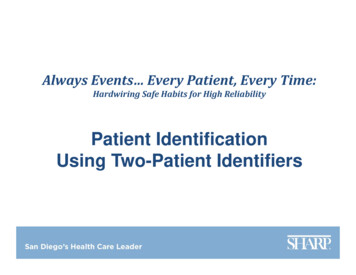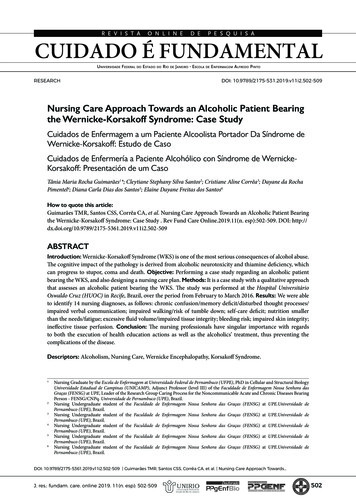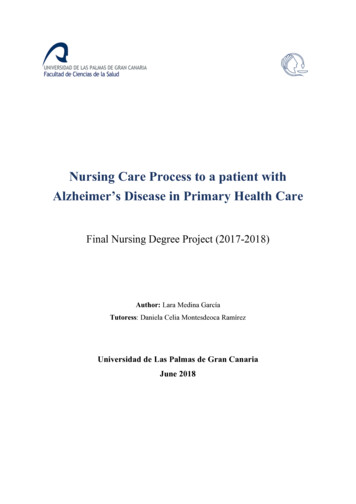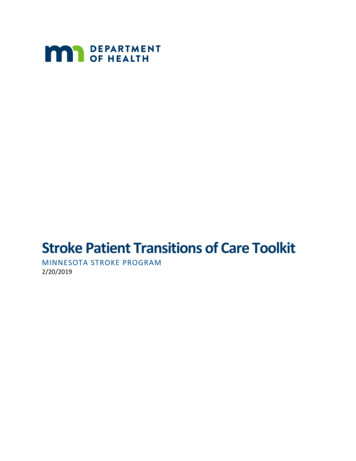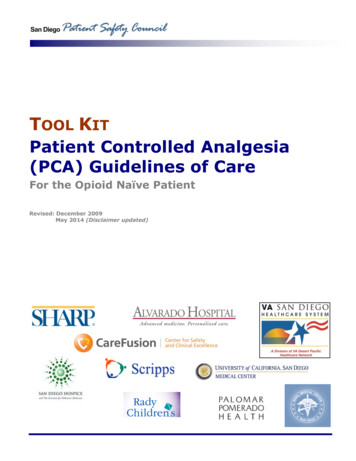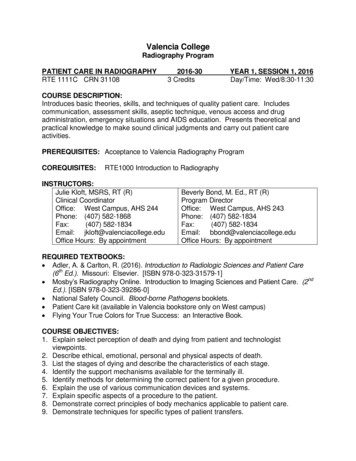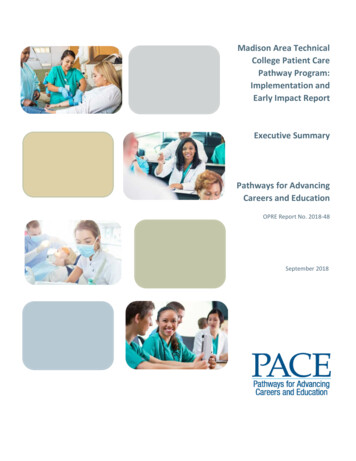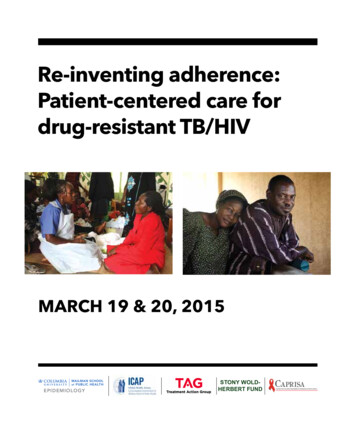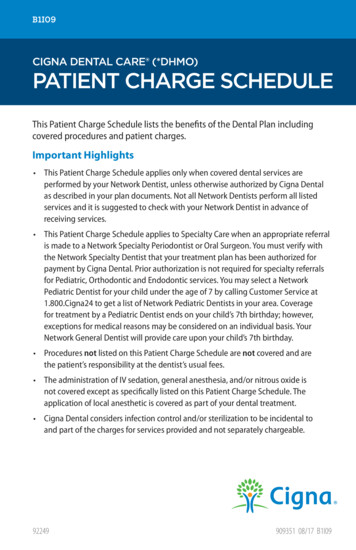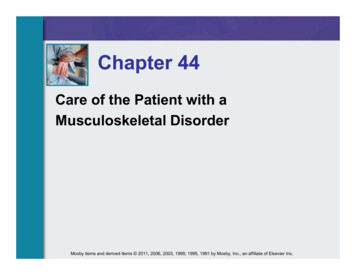
Transcription
Chapter 44Care of the Patient with aMusculoskeletal DisorderMosby items and derived items 2011, 2006, 2003, 1999, 1995, 1991 by Mosby, Inc., an affiliate of Elsevier Inc.
Overview of Anatomy andPhysiology Functions of the skeletal system SupportProtectionMovementMineral storageHemopoiesis Structure of bones Four classifications based on form and shape Long, short, flat, and irregularMosby items and derived items 2011, 2006, 2003, 1999, 1995, 1991 by Mosby, Inc., an affiliate of Elsevier Inc.Slide 2
Figure 44-2(From Thibodeau, G.A., Patton, K.T. [2005]. The human body in health and disease. [4th ed.]. St. Louis: Mosby.)Skeleton, anterior view.Mosby items and derived items 2011, 2006, 2003, 1999, 1995, 1991 by Mosby, Inc., an affiliate of Elsevier Inc.Slide 3
Figure 44-3(From Thibodeau, G.A., Patton, K.T. [2005]. The human body in health and disease. [4th ed.]. St. Louis: Mosby.)Skeleton, posterior view.Mosby items and derived items 2011, 2006, 2003, 1999, 1995, 1991 by Mosby, Inc., an affiliate of Elsevier Inc.Slide 4
Overview of Anatomy andPhysiology Articulations (joints) Allow movementThree types according to degree of movement Synarthrosis—no movement Amphiarthrosis—slight movement Diarthrosis—free movement Divisions of the skeleton Axial skeletonAppendicular skeletonMosby items and derived items 2011, 2006, 2003, 1999, 1995, 1991 by Mosby, Inc., an affiliate of Elsevier Inc.Slide 5
Figure 44-1(From Thibodeau, G.A., Patton, K.T. [2008]. Structure and function of the body. [13th ed.]. St. Louis: Mosby.)Structure of a freely movable (diarthrotic) joint.Mosby items and derived items 2011, 2006, 2003, 1999, 1995, 1991 by Mosby, Inc., an affiliate of Elsevier Inc.Slide 6
Overview of Anatomy andPhysiology Functions of the muscular system MotionMaintenance of postureProduction of heat Skeletal muscle structure EpimysiumPerimysiumEndomysiumMosby items and derived items 2011, 2006, 2003, 1999, 1995, 1991 by Mosby, Inc., an affiliate of Elsevier Inc.Slide 7
Figure 44-5(From Thibodeau, G.A., Patton, K.T. [2005]. The human body in health and disease. [4th ed.]. St. Louis: Mosby.)Anterior view of the body.Mosby items and derived items 2011, 2006, 2003, 1999, 1995, 1991 by Mosby, Inc., an affiliate of Elsevier Inc.Slide 8
Figure 44-6(From Thibodeau, G.A., Patton, K.T. [2005]. The human body in health and disease. [4th ed.]. St. Louis: Mosby.)Posterior view of the body.Mosby items and derived items 2011, 2006, 2003, 1999, 1995, 1991 by Mosby, Inc., an affiliate of Elsevier Inc.Slide 9
Overview of Anatomy andPhysiology Nerve and blood supply Blood vessels provide a constant supply of oxygenand nutrition, and nerve cells/fibers supply a constantsource of information Muscle contraction Muscle stimulus—when a muscle cell is adequatelystimulated, it will contractMuscle tone—skeletal muscles are in a constant stateof readiness for actionTypes of body movements—flexion, extension,abduction, adduction, rotation, supination, pronation,dorsiflexion, and plantar flexionMosby items and derived items 2011, 2006, 2003, 1999, 1995, 1991 by Mosby, Inc., an affiliate of Elsevier Inc.Slide 10
Laboratory and DiagnosticExaminations Radiographic studies MyelogramNuclear scanningMagnetic resonance imaging (MRI)Computed axial tomography (CT or CAT scan)Bone scan Endoscopic examination ArthroscopyEndoscopic spinal microsurgeryMosby items and derived items 2011, 2006, 2003, 1999, 1995, 1991 by Mosby, Inc., an affiliate of Elsevier Inc.Slide 11
Laboratory and DiagnosticExaminations Aspiration Synovial fluid aspiration Electrographic procedure Electromyogram (EMG) Laboratory tests CalciumErythrocyte sedimentation rate (ESR)Lupus erythematosus (LE) preparationRheumatoid factor (RF)Uric acid (blood)Mosby items and derived items 2011, 2006, 2003, 1999, 1995, 1991 by Mosby, Inc., an affiliate of Elsevier Inc.Slide 12
Inflammatory Disorders of theMusculoskeletal System Rheumatoid arthritis Etiology/pathophysiology Most serious form of arthritisChronic, systemic diseaseMost common in women of childbearing ageAutoimmune disorder, but may also be geneticMay affect lungs, heart, blood vessels, muscles, eyes,and skin Chronic inflammation of the synovial membrane of thediarthrodial joints (movable)Mosby items and derived items 2011, 2006, 2003, 1999, 1995, 1991 by Mosby, Inc., an affiliate of Elsevier Inc.Slide 13
Inflammatory Disorders of theMusculoskeletal System Rheumatoid arthritis (continued) Clinical manifestations/assessment Characterized by periods of remission and exacerbationMalaiseMuscle weaknessLoss of appetiteGeneralized achingEdema and tenderness of jointsLimited range of motion (morning stiffness)Mosby items and derived items 2011, 2006, 2003, 1999, 1995, 1991 by Mosby, Inc., an affiliate of Elsevier Inc.Slide 14
Figure 44-7(From Kamal, A., Brocklehurst, J.C. [1991]. Color atlas of geriatric medicine. [2nd ed.]. St. Louis: Mosby.)Rheumatoid arthritis of hands.Mosby items and derived items 2011, 2006, 2003, 1999, 1995, 1991 by Mosby, Inc., an affiliate of Elsevier Inc.Slide 15
Inflammatory Disorders of theMusculoskeletal System Rheumatoid arthritis (continued) Diagnostic tests Radiography studies show loss of articular cartilage andchange in bone structure Laboratory tests Erythrocyte sedimentation rate (ESR)Rheumatoid factor (RF)Latex agglutination testSynovial fluid aspirationMosby items and derived items 2011, 2006, 2003, 1999, 1995, 1991 by Mosby, Inc., an affiliate of Elsevier Inc.Slide 16
Inflammatory Disorders of theMusculoskeletal System Rheumatoid arthritis (continued) Medical management/nursing interventions Pharmacological management Salicylates, NSAIDs, COX-2 inhibitors, anti-inflammatoryagents, disease-modifying antirheumatoid drugsRest: 8 to 10 hours of sleep a nightExercise: Range of motion two to three times per dayHeat: Hot packs, heat lamp, and/or hot paraffinRehabilitationMosby items and derived items 2011, 2006, 2003, 1999, 1995, 1991 by Mosby, Inc., an affiliate of Elsevier Inc.Slide 17
Inflammatory Disorders of theMusculoskeletal System Ankylosing spondylitis Etiology/pathophysiology Chronic, progressive disorder of the sacroiliac and hipjoints, the synovial joints of the spine, and the adjacentsoft tissues Most common in young men Strong hereditary tendency Clinical manifestations/assessment Pain and stiffness in back; decreased ROM Elevated temperature; tachycardia; hyperpneaMosby items and derived items 2011, 2006, 2003, 1999, 1995, 1991 by Mosby, Inc., an affiliate of Elsevier Inc.Slide 18
Inflammatory Disorders of theMusculoskeletal System Ankylosing spondylitis (continued) Diagnostic tests Hemoglobin, hematocrit, ESR, alkaline phosphatase Radiographic Medical management/nursing interventions Pharmacological management Analgesics, NSAIDsExercise program: swimming and walkingSurgery: replace fused jointsMaintain spine alignmentTurn, position, and breathing exercises every 2 hoursMosby items and derived items 2011, 2006, 2003, 1999, 1995, 1991 by Mosby, Inc., an affiliate of Elsevier Inc.Slide 19
Inflammatory Disorders of theMusculoskeletal System Osteoarthritis (degenerative joint disease) Etiology/pathophysiology Nonsystemic, noninflammatory disorder thatprogressively causes bones and joints to degenerate Primary Cause is unknown Secondary Caused by trauma, infections, previous fractures,rheumatoid arthritis, stress on weight-bearing jointsMosby items and derived items 2011, 2006, 2003, 1999, 1995, 1991 by Mosby, Inc., an affiliate of Elsevier Inc.Slide 20
Figure 44-9(From Kamal, A., Brocklehurst, J.C. [1991]. Color atlas of geriatric medicine. [2nd ed.]. St. Louis: Mosby.)Heberden’s nodes.Mosby items and derived items 2011, 2006, 2003, 1999, 1995, 1991 by Mosby, Inc., an affiliate of Elsevier Inc.Slide 21
Inflammatory Disorders of theMusculoskeletal System Osteoarthritis (degenerative joint disease)(continued) Clinical manifestations/assessment Joint edema, tenderness, instability, and deformity Heberden’s nodes Bouchard’s nodes Diagnostic tests Radiographic studiesArthroscopySynovial fluid examinationBone scansMosby items and derived items 2011, 2006, 2003, 1999, 1995, 1991 by Mosby, Inc., an affiliate of Elsevier Inc.Slide 22
Inflammatory Disorders of theMusculoskeletal System Osteoarthritis (degenerative joint disease)(continued) Medical management/nursing interventions Pharmacological management Salicylates, NSAIDs, corticosteroids, glucosaminesupplementsExercise balanced with restHeat applicationsGait enhancers (canes, walkers, etc.)Surgery OsteotomyJoint replacementMosby items and derived items 2011, 2006, 2003, 1999, 1995, 1991 by Mosby, Inc., an affiliate of Elsevier Inc.Slide 23
Inflammatory Disorders of theMusculoskeletal System Gout (gouty arthritis) Etiology/pathophysiology Metabolic disease resulting from an accumulation ofuric acid in the blood Caused by an ineffective metabolism of purines Primary: hereditary factors Secondary: use of certain drugs, complication of otherdiseases, or idiopathic Affects men more frequently than women Does not occur before puberty in males or beforemenopause in femalesMosby items and derived items 2011, 2006, 2003, 1999, 1995, 1991 by Mosby, Inc., an affiliate of Elsevier Inc.Slide 24
Inflammatory Disorders of theMusculoskeletal System Gout (gouty arthritis) (continued) Clinical manifestations/assessment Excruciating painEdemaInflammation (most common in the great toe)TophiDiagnostic tests Serum and uric acid level, CBC, ESR Radiography studies Synovial fluid aspirationMosby items and derived items 2011, 2006, 2003, 1999, 1995, 1991 by Mosby, Inc., an affiliate of Elsevier Inc.Slide 25
Inflammatory Disorders of theMusculoskeletal System Gout (gouty arthritis) (continued) Medical management/nursing interventions Pharmacological management Colchicine, phenylbutazone (Butazolidin), indomethacin(Indocin), corticosteroids, allopurinol (Zyloprim),sulfinpyrazone (Anturane)Encourage fluid intakeMonitor intake and outputBed rest and joint immobilizationDietary restrictionsMosby items and derived items 2011, 2006, 2003, 1999, 1995, 1991 by Mosby, Inc., an affiliate of Elsevier Inc.Slide 26
Other Disorders of theMusculoskeletal System Osteoporosis Etiology/pathophysiology Reduction of bone mass Most common in women ages 55 to 65 Contributing factors: immobilization; steroids; highintake of caffeine; diet low in calcium, high in protein;smoking; sedentary lifestyle Clinical manifestations/assessment Backache Porous and brittle bones Dowager’s humpMosby items and derived items 2011, 2006, 2003, 1999, 1995, 1991 by Mosby, Inc., an affiliate of Elsevier Inc.Slide 27
Other Disorders of theMusculoskeletal System Osteoporosis (continued) Diagnostic tests CBC, serum calcium, phosphorus, alkalinephosphatase, blood urea nitrogen, creatinine level,urinalysis, liver and thyroid function tests Radiography studies Medical management/nursing interventions Pharmacological management Calcium supplements, vitamin DEstrogen, alendronate (Fosamax) Weight-bearing exercises Dietary recommendationsMosby items and derived items 2011, 2006, 2003, 1999, 1995, 1991 by Mosby, Inc., an affiliate of Elsevier Inc.Slide 28
Other Disorders of theMusculoskeletal System Osteomyelitis Etiology/pathophysiology Local or generalized infection of the bone and bonemarrow Staphylococci are the most common cause Introduced through trauma (injury or surgery) or via thebloodstream from another site in the body to the bone Bacteria invade the bone and degeneration of boneoccursMosby items and derived items 2011, 2006, 2003, 1999, 1995, 1991 by Mosby, Inc., an affiliate of Elsevier Inc.Slide 29
Other Disorders of theMusculoskeletal System Osteomyelitis (continued) Clinical manifestations/assessment Persistent, severe, and increasing bone pain Wound draining purulent fluid Signs and symptoms of infection: temperature,tachycardia, and tachypnea Edema of affected area Diagnostic tests Radiography studies; bone scan CBC; ESR; cultures of blood and drainageMosby items and derived items 2011, 2006, 2003, 1999, 1995, 1991 by Mosby, Inc., an affiliate of Elsevier Inc.Slide 30
Other Disorders of theMusculoskeletal System Osteomyelitis (continued) Medical management/nursing interventions Pharmacological management Antibiotic therapy Surgery: removal of necrotic bone Absolute rest of affected extremity Wound care Irrigate with hydrogen peroxide or antibiotic solution;cover with sterile dressing Drainage and secretion precautions Dietary recommendations: high in calories, protein, andvitaminsMosby items and derived items 2011, 2006, 2003, 1999, 1995, 1991 by Mosby, Inc., an affiliate of Elsevier Inc.Slide 31
Other Disorders of theMusculoskeletal System Fibromyalgia syndrome (FMS) Etiology/pathophysiology Musculoskeletal chronic pain syndrome Unknown etiology Clinical manifestations/assessment Generalized achingIrritable bowel syndromeTension headacheParesthesia of upper extremitiesSensation of edematous handsMosby items and derived items 2011, 2006, 2003, 1999, 1995, 1991 by Mosby, Inc., an affiliate of Elsevier Inc.Slide 32
Other Disorders of theMusculoskeletal System Fibromyalgia syndrome (FMS) (continued) Diagnostic tests No specific laboratory or radiographic tests diagnoseFMS Medical management/nursing interventions Pharmacological management Tricyclic antidepressants Patient education and reassurance Exercise Relaxation techniquesMosby items and derived items 2011, 2006, 2003, 1999, 1995, 1991 by Mosby, Inc., an affiliate of Elsevier Inc.Slide 33
Surgical Interventions for TotalKnee or Total Hip Replacement Knee arthroplasty (total knee replacement) Replacement of the
Rheumatoid arthritis (continued) Medical management/nursing interventions Pharmacological management Salicylates, NSAIDs, COX-2 inhibitors, anti-inflammatory agents, disease-modifying antirheumatoid drugs Rest: 8 to 10 hours of sleep a night

